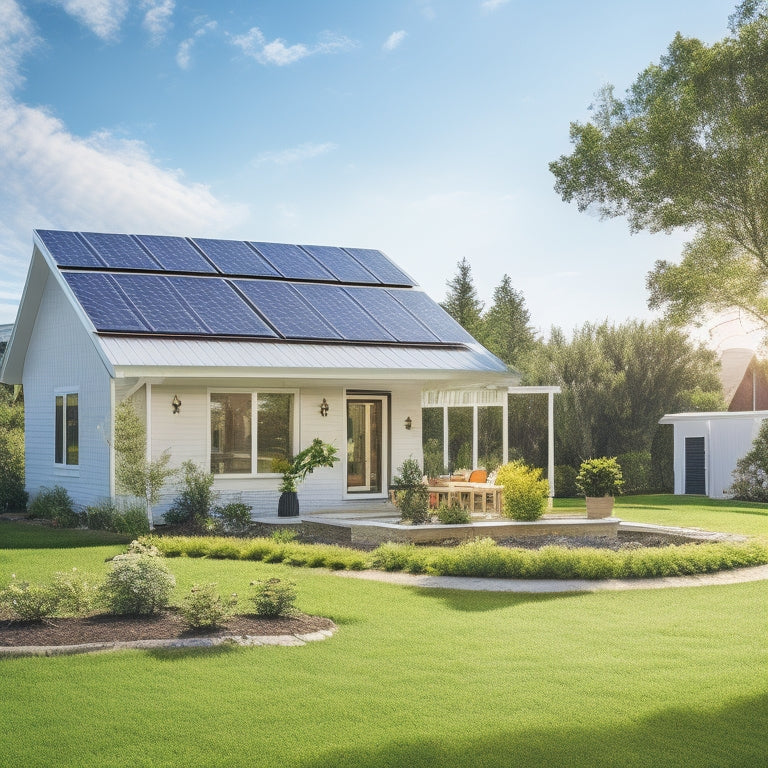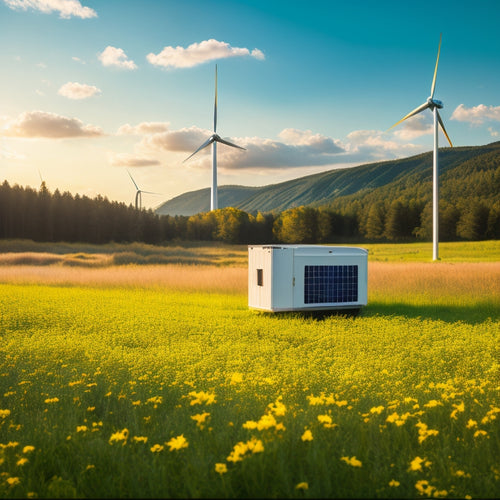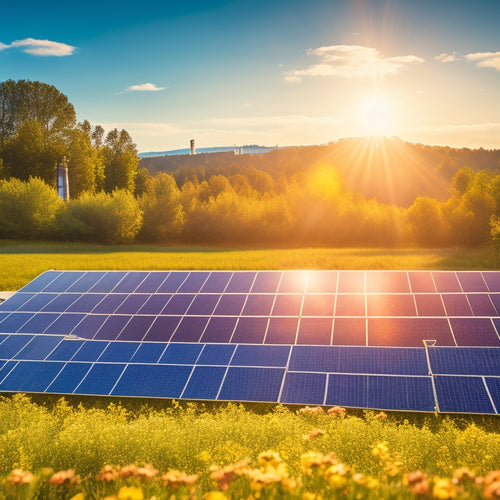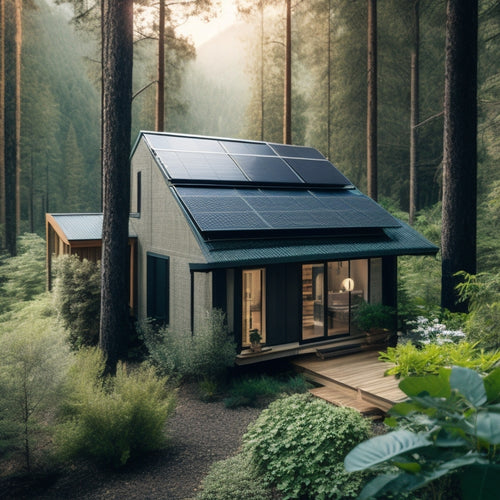
DIY Home Energy Independence Made Easy
Share
To achieve DIY home energy independence, you'll need to assess your energy needs by analyzing past utility bills and conducting an energy audit to identify high-usage areas. Then, choose the right solar panels by evaluating efficiency ratings, durability, and installation costs. Prepare your roof by inspecting for damage and ensuring it can support the solar panels. Install the mounts securely, and connect to a battery system that suits your needs. By monitoring your energy output and optimizing your system, you can greatly reduce your reliance on the grid. As you take these steps, you'll reveal the secrets to generating your own clean energy and achieving true independence.
Key Takeaways
- Analyze your household's energy consumption patterns to identify areas for improvement and optimize energy usage.
- Choose the right solar panels based on efficiency ratings, durability, and installation costs to maximize energy output.
- Ensure a safe and efficient energy storage system by selecting the suitable battery type and connection method for your needs.
- Monitor your energy output and consumption in real-time to identify areas for improvement and optimize your DIY energy independence system.
- Optimize wind energy capture by placing turbines in ideal locations, adjusting blade angles, and monitoring wind speed data.
Assessing Your Energy Needs
To achieve DIY home energy independence, you must first determine how much energy your household consumes. This involves analyzing your lifestyle habits and understanding your energy consumption patterns.
Start by reviewing your past utility bills to identify your average daily energy usage in kilowatt-hours (kWh). Consider the number of occupants, appliances, and lighting fixtures in your home.
Additionally, think about your daily routines, such as when you use the most energy-intensive appliances. Conducting an energy audit can help you identify high usage areas and potential reductions, allowing you to optimize your energy usage.
Choosing the Right Solar Panels
You're ready to take the next step in achieving DIY home energy independence: selecting the right solar panels for your needs. There are several solar panel types to evaluate, including monocrystalline, polycrystalline, and thin-film panels. Each type has its own efficiency rating, which affects energy output.
When assessing panels, reflect on the durability of frames, such as anodized aluminum or stainless steel, which provide corrosion resistance and structural integrity. Additionally, weather-tight enclosures with high IP ratings protect against dust and water ingress.
Installation costs vary depending on the type and quality of the panels. Warranty options, typically 25 years or more, should also be taken into account. Aesthetics considerations, such as panel color and frame type, may impact your decision.
Research brand comparisons to ascertain you're getting the best value. Additionally, think about the environmental impact, maintenance requirements, and local incentives that may be available. By evaluating these factors, you can choose the right solar panels for your DIY energy independence project.
Preparing Your Home's Roof
You'll need to assess your roof's condition to guarantee it can support the weight of solar panels and withstand environmental elements. This involves inspecting for damaged, missing, or loose shingles, curled or buckled shingles, and signs of animal or insect infestation.
When selecting solar panels, consider high-efficiency options with a minimum 25-year warranty for reliable energy production.
Additionally, consider energy efficiency upgrades, such as adding insulation or installing a radiant barrier, to maximize your roof's energy-saving potential.
Roof Condition Assessment
Your roof is the first line of defense against the elements, and its condition plays a critical role in determining the success of your DIY home energy independence project. You must assess its condition to confirm it's ready for the energy-efficient upgrades to come.
Start by inspecting your roof for damaged, missing, or loose shingles, curled or buckled shingles, and signs of wear around chimneys, vents, and skylights. Check for sagging or uneven rooflines, and look for signs of animal infestation or plant growth.
Proper roof maintenance tips, such as regular inspections and repairs, can help prevent costly issues down the line. Additionally, roof insulation benefits like reduced heat loss and energy savings can be achieved with proper installation and maintenance.
Energy Efficiency Upgrades
With a solid roof condition assessment under your belt, it's time to focus on energy efficiency upgrades that will prepare your home's roof for peak performance.
Start by conducting an energy audit to identify areas of heat loss and gain. Next, improve insulation in your attic, walls, and floors to reduce heat transfer.
Install smart thermostats and LED lighting to optimize energy use. Update window treatments to reduce heat gain during summer and heat loss during winter.
Replace old appliances with energy-efficient ones, and apply weatherization techniques to seal air leaks.
Finally, consider renewable resources like solar panels to generate electricity.
Installing Solar Panel Mounts
The solar panel mounting system is a critical component of your DIY home energy independence project, as it securely fastens the panels to your roof and guarantees maximum energy harvesting.
You'll need to choose a mounting technique that suits your roof type and solar panel configuration. Popular mounting techniques include roof-ground mounts, tilt mounts, and adjustable mounts.
Make certain you have the necessary installation tools, such as a drill, level, and wrench, to secure the mounts to your roof.
Follow the manufacturer's instructions to assemble the mounting system, taking care to align the panels correctly.
Properly installed mounts will maximize energy production and prevent damage to your roof or solar panels.
Connecting to a Battery System
Energy storage is an important aspect of your DIY home energy independence project, as it enables you to make use of excess energy generated by your solar panels during the day for use at night or during power outages. When connecting to a battery system, you'll need to take into account the type of battery and connection method.
| Battery Type | Connection Method |
|---|---|
| Lead-Acid | Series or Parallel |
| Lithium-Ion | Balancing or Modular |
| Nickel-Cadmium | Series or Parallel |
| Sodium-Ion | Balancing or Modular |
| Flow Battery | Series or Shunt |
Common connection methods include series, parallel, balancing, modular, and shunt connections. Each has its advantages and disadvantages, depending on your specific energy needs and battery type. Understanding these options is vital to guarantee a safe and efficient energy storage system.
Monitoring Your Energy Output
You'll need to track your energy production to optimize your DIY home energy independence system.
Monitoring your energy output allows you to identify areas for improvement and guarantee you're meeting your energy needs.
With real-time usage updates, you'll be able to adjust your energy habits and maximize your system's performance.
Energy Production Tracking
Monitoring your energy output is essential to achieving true DIY home energy independence. With a tracking system in place, you'll be able to optimize your energy production and identify areas for improvement. This is particularly important for solar-powered systems, where fluctuations in solar performance can greatly impact your output efficiency.
Here are three key benefits of energy production tracking:
-
Accurate production metrics: Get precise data on your energy output, allowing you to fine-tune your system for maximum efficiency.
-
Data analysis and observations: Uncover trends and patterns in your energy production, enabling you to make informed decisions about your energy usage.
-
Energy forecasting and planning: Use historical data to predict future energy demand, ensuring you're always prepared to meet your energy needs.
Real-Time Usage Updates
Your solar panels or wind turbines are generating power, but how much? Monitoring your energy output in real-time is essential to understanding your energy consumption and usage patterns. This information enables you to optimize your energy production, reduce waste, and make informed decisions about your energy independence.
| Energy Source | Real-Time Data | Benefits |
|---|---|---|
| Solar Panels | kW/h, voltage, current | Identify peak sun hours, optimize panel angle |
| Wind Turbines | RPM, kW/h, wind speed | Determine ideal turbine placement, optimize blade angle |
| Energy Storage | State of charge, discharge rate | Monitor battery health, optimize charging/discharging |
With real-time usage updates, you can pinpoint areas of inefficiency and make data-driven decisions to maximize your energy independence.
Frequently Asked Questions
Can I Install Solar Panels on a Metal or Clay Tile Roof?
You can install solar panels on a metal or clay tile roof, but it's essential to verify solar panel compatibility with your specific roof material; consider factors like weight, durability, and waterproofing to confirm a secure and efficient installation.
How Long Does a Typical Solar Panel Installation Take?
You'll typically spend 3-5 days on a solar panel installation, depending on the complexity of the job. During this installation timeline, a professional team will complete the installation process, from evaluating your roof to connecting the system to the grid.
Are Solar Panels Resistant to Extreme Weather Conditions?
You're wondering if solar panels can withstand Mother Nature's fury? Rest assured, you'll find they're built to last, with solar panel durability that shines through in extreme weather performance, from scorching heat to torrential rains and fierce winds.
Can I Add More Solar Panels to My Existing System?
You can expand your solar panel setup by adding more panels, but first, you'll need to verify system compatibility, checking your inverter's capacity and evaluating your roof's structural integrity to support the additional weight and energy output.
Do I Need to Replace My Old Electrical Panel for Solar?
Did you know that 70% of US homes need electrical panel upgrades for solar? You'll need a solar compatibility assessment to determine if your old panel can handle the added power, or if an upgrade is necessary.
Related Posts
-

Sustainable and Eco-Friendly Generators for a Reduced Carbon Footprint
Sustainable and eco-friendly generators are perfect for cutting your carbon footprint and increasing energy efficienc...
-

Advantages of Solar Generating Systems Over Traditional Energy
Solar generating systems provide several key advantages over traditional energy sources. You'll experience lower long...
-

Off Grid Solar Batteries
As you shift to off-grid living, you'll rely on high-performance solar batteries to store excess energy generated by ...


